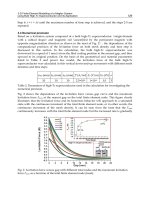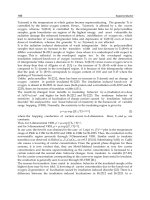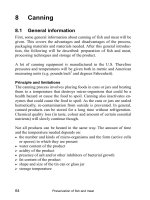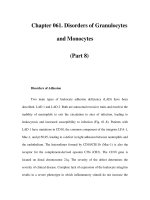Handbook of Advanced Interventional Cardiology - part 8 pot
Bạn đang xem bản rút gọn của tài liệu. Xem và tải ngay bản đầy đủ của tài liệu tại đây (1.18 MB, 68 trang )
456 Practical Handbook of Advanced Interventional Cardiology
To solve the problem of a weak platform created by a
fl oppy wire (mechanism 1), the wire has to be advanced
further so the stiff segment is in the proper area. If the wire is
not strong enough, it has to be exchanged to a stiffer one.
65
To solve the problem of acute angle at the origin of the
artery (mechanism 2), a stiff wire will straighten out the
angle and help to advance the wire. To solve the problem
created by mechanism 3 due to excessive friction between
the wire and the internal surface of the catheter, the cath-
eter should be advanced and the guidewire withdrawn
Figure 22-14: Diffi culty in advancing the catheter over the
guidewire. (A) The catheter forms a loop in the aorta. (B)
The tip of the catheter fl ips back into the aorta. (Adapted from
Gerlock AJ, Mirfakhraee M. Diffi culty in catheterization of the
internal and external carotid arteries. In: Gerlock AJ, Mirfa-
khraee M, eds. Essentials of Diagnostic and Interventional
Angiographic Techniques. WB Saunders, 1985. With permis-
sion from the publisher.)
Table 22-6
Mechanisms of failure in advancing the catheter
1. The wire is not strong enough to support the catheter.
2. The angle of the origin of the carotid artery is too acute.
3. Too much friction exists between the guidewire and the
internal surface of the catheter.
4. The curve of the distal end of the catheter prevents further
advancement.
Carotid Artery Interventions 457
simultaneously (Figure 22-15). This maneuver reduces
signifi cantly the friction between the wire and the internal
surface of the catheter. Another way is to change the size
of the wire to a smaller one, although this wire would not
provide the same support as the previous wire; however, it
would help to advance the catheter if the problem is related
primarily to friction rather than support.
65
To solve the problem of mechanism 4 (a sharp angle at
the end of the catheter), while the wire is fi xed, the catheter
is advanced over it while rotating the catheter gently. The
goal is to straighten the distal segment of the catheter by the
wall of the artery so the catheter can adopt itself more to the
angle and be advanced further (Figure 22-16). In diffi cult
situations, two or three of the above-mentioned maneuvers
may be required before the tip of the catheter can be ad-
vanced to the desired level.
***Carotid access in presence of occluded ECA, CCA
lesion below bifurcation, or ostial CCA lesion: Placing
the 7F 90-cm access sheath into the CCA may present
Figure 22-15: Diagram showing how to reduce the friction
between the wire and the internal surface of the catheter. (A)
The catheter tip is at the orifi ce of the left CCA and the tip of the
wire is in the left ICA. (B) The catheter is advanced while the
wire is withdrawn. (Adapted from Gerlock AJ, Mirfakhraee M.
Diffi culty in catheterization of the internal and external carotid
arteries. In: Gerlock AJ, Mirfakhraee M, eds. Essentials of
Diagnostic and Interventional Angiographic Techniques. WB
Saunders, 1985. With permission from the publisher.)
458 Practical Handbook of Advanced Interventional Cardiology
special challenges when the ECA is occluded, a critical
lesion is situated below the bifurcation, or there is a critical
ostial common carotid lesion. If possible, avoid crossing
the lesion with a stiff 0.038" wire since this is more likely
to disrupt the necrotic plaque material and cause distal
embolization. When possible, advance the 5F diagnostic
guide over the 0.038" glidewire to be placed more distally. In
this situation, the glidewire and 5F guide are fi rst advanced
through the lesion. This maneuver should be done only in
patients considered at high risk from carotid surgery if the
risk-benefi t ratio still favors stenting.
In the presence of a carotid ostial lesion, the origin of
the CCA should be fi rst dilated to allow sheath access. The
bifurcation should be stented fi rst, and the ostium stented
with a Palmaz stent on the “way out”.
***Choice of balloon expandable or self-expandable
stents: The use of balloon expandable stents was aban-
doned with 3 exceptions listed in Table 22-7. Forcing the
current high-profi le delivery systems may break off plaque
and cause distal embolization. In this situation, a short bal-
Figure 22-16: Straightening the tip of the catheter by the wall
of the artery. (A) The tip of the catheter is at the orifi ce of the
left CCA. (B) While the wire is fi xed, the catheter is advanced
over it using rotating forward movement. (C) The catheter has
advanced over the wire into the vessel. (Adapted from Gerlock
AJ, Mirfakhraee M. Diffi culty in catheterization of the internal
and external carotid arteries. In: Gerlock AJ, Mirfakhraee M,
eds. Essentials of Diagnostic and Interventional Angiograph-
ic Techniques. WB Saunders, 1985. With permission from the
publisher.)
Carotid Artery Interventions 459
loon expandable stent may be placed to hold the lesion
open before passing a defi nitive self-expanding stent.
**Postdilation: It is safer to underdilate than overdilate the
oversized self-expanding stents. Overdilatation squeezes
the atherosclerotic material through the stent mesh, caus-
ing emboli. A 10–15% remaining stenosis does not cause
clinical problems. Importantly, it is not necessary to dilate
the stent to obliterate segments of contrast-fi lled ulcer-
ations external to the stent. This angiographic appearance
is of no prognostic signifi cance and follow-up angiography
has documented complete fi brotic healing of these lesions
over time. Importantly, it is not necessary to overexpand
the stent to produce a 0% residual diameter narrowing.
Covering the external carotid artery with a stent does not
cause problems. Our follow-up arteriograms showed the
external carotid artery to be patent with rare exceptions. If
the external carotid artery becomes signifi cantly stenosed
with <TIMI-3 fl ow or occluded after postdilation of the stent,
this vessel can be approached through the stent mesh, and
reopened using coronary balloon techniques. A 0.014" wire
is used to enter the external carotid artery, a 2-mm balloon
to predilate, and a 4-mm balloon for fi nal dilation. However
there is almost never a clinical indication to do this.
COMPLICATIONS OF CAROTID INTERVENTIONS
Although major complications can be encountered dur-
ing the learning curve of carotid angioplasty and stenting,
66
they are minimized by the use of meticulous techniques.
Thrombotic and embolic complications: A recent
survey on carotid artery angioplasty and stenting
67
revealed
a 30-day minor stroke rate of 2.72% and a major stroke rate of
1.49%. Advantages of the endovascular approach over CEA
include the ability to immediately diagnose and treat these
complications, and the patient can be awake, allowing close
Table 22-7
Indications for use of balloon expandable stents
1. When the ostium of the common carotid artery is treated
and the proximal end of the stent has to be placed with
precision.
2. When the most distal segment of the internal carotid
artery is treated (present delivery systems for a self-
expanding stent cause dissections in the petrous portion
of the internal carotid artery).
3. When the self-expanding stent delivery system will not
pass through a calcifi ed, recoiling lesion.
460 Practical Handbook of Advanced Interventional Cardiology
neurologic monitoring. For acute thrombosis, local intra-ar-
terial thrombolysis can be carried out using mechanical as
well as chemical disruption of the clot.
68
Extreme care must
be exercised to avoid vessel perforation. Only very fl exible
microcatheters and soft wires may be used in the intracerebral
circulation.
To prevent thrombotic complications, investigators have
advocated the use of glycoprotein 2b3a platelet inhibition.
69
However, this encounters the risk of cerebral bleeding and
therefore it should not be used routinely. Today, embolic
protection devices are widely used although no randomized
trials with versus without protection have been performed.
70
Atherosclerotic debris can be found in the fi lter in the majority
of cases. Therefore, most investigators consider it to be un-
ethical to conduct such a trial.
Carotid artery spasm: Guidewire-induced phenomena
are minimized by the use of 0.014–0.018" wires. Carotid artery
spasm can be successfully treated with papaverine
21
or nitro-
glycerin. Often they disappear spontaneously.
Transient bradyarrythmias and hypotension: Medi-
ated by stretch of the carotid baroreceptors. This can usually
be avoided by atropine given at least 2 to 3 minutes before
balloon infl ation.
Asystole is very rare, but if it occurs, it is transient and
resolves with balloon defl ation. A routine pacemaker is not
necessary.
Post-stenting hypotension: Mediated by stretch of the
carotid baroreceptors. Treat aggressively if the patient has
severe distal or contralateral disease. Puncture site complica-
tions should be ruled out.
58
External carotid artery occlusion: Acute occlusion of
the ECA is well tolerated. In the absence of collateral circula-
tion, patients may experience jaw muscle angina which is
usually transient.
Stent restenosis: The restenosis rate for carotid stent-
ing is less than 10%. It is treated with balloon dilatation.
71
A
new stenosis may occur at the distal end of a stiff stent. This
may require an additional stent.
Carotid perforation: This can be seen after excessive
balloon sizing prior to or after stent placement. If encoun-
tered, try to seal it with a prolonged balloon infl ation. Covered
stents can be used if there is no compromise of major side
branches.
Carotid dissection: This is seen mainly in areas of ves-
sel tortuosity or calcifi cation. Stented segments should not
be overdilated in comparison to the reference vessel. Further
stenting may be necessary to avoid fl ow disruption in the area
of dissection.
Cerebral hemorrhage: Associated with a combination
of excessive anticoagulation, uncontrolled hypertension,
intracranial vessel manipulation, and stenting after a recent
Carotid Artery Interventions 461
stroke (<3 weeks). Terminate the procedure, reverse the
anticoagulation, and control the hypertension. An emergency
brain CT scan should be performed. Operators should be fa-
miliar with the angiographic features of an intracranial mass
effect. Sudden loss of consciousness preceded by a severe
headache in the absence of intracranial vessel occlusion
should alert the operator to this devastating event. Fortu-
nately, with careful patient selection and compulsive attention
to the above technical and anticoagulation issues, cerebral
hem orrhage sh ould b e a ver y r are oc currence.
Jaw claudication: After carotid stenting, some patients
complain of pain when masticating, especially if the ECA is
jailed. Jaw claudication should slowly disappear in 1 to 2
weeks.
Problems and complications with embolic protec-
tion devices: Embolic protection devices may also cause
problems. All devices placed distally in the internal carotid ar-
tery may cause spasm or dissection. Rarely additional balloon
infl ations and/or stent implantations have been necessary to
solve the problem. It may be diffi cult to retrieve these devices
through the implanted stent. It may happen that the fi lter is not
fully apposed to the vessel wall. In contrast, the major disad-
vantage of the occlusion devices is intolerance in patients with
occlusion or high-grade stenosis of the contralateral internal
carotid artery or patients with poorly developed intracranial
collaterals. A specifi c disadvantage of the MO.MA and the
ArteriA device is the need for a large sheath, which may cause
vascular access problems.
FUTURE DIRECTIONS
Future developments in the fi eld of carotid percutaneous
intervention will include new stents with higher fl exibility which
can be introduced through smaller sheaths (5F). We will have
improved embolic protection devices with better wall apposi-
tion and without need for a retrieval catheter. All these new
developments will help carotid stenting to become the new
gold standard for treatment of carotid arteriosclerotic disease
within the next few years.
REFERENCES
1. Wolf PA, Kannel WB, McGee PC. Epidemiology of strokes
in North America. In: Barnet HJM, Stein BM, Mohr JP, Yatsu
FM, eds. Stroke: Pathology, Diagnosis and Management. Vol
1. Churchill Livingstone, 1986: 1929.
2. Eastcott HHG, Pickering GW, Rob CG. Reconstruction of
ICA in a patient with intermittent attacks of hemiplegia. Lancet
1954; 267/II: 994–6.
462 Practical Handbook of Advanced Interventional Cardiology
3. DeBakey M. Carotid endarterectomy revisited. J Endovasc
Surg 1996; 3 (1): 4.
4. Fields W, Maslenikov V, Meyer J et al. Joint study of
extracranial arterial occlusion. J Am Med Assoc 1970; 211:
1993–2003.
5. Shaw D, Venables G, Cartlidge N et al. Carotid
endarterectomy in patients with transient cerebral ischemia. J
Neurol Sci 1984; 64: 45–53.
6. Yadav JS, Roubin GS, Iyer S et al. Application of lessons
learned from cardiac interventional techniques to carotid
angioplasty. J Am Coll Cardiol 1995; 25: 392A.
7. Mathias K, Mittermayer C, Ensinger H et al. Perkutane
Katheterdilatation von Karotisstenosen. Rofo Fortschr Geb
Rontgenstr Neuen Bildgeb Verfahr 1980; 133: 258–261.
8. Mathias K. Katheterbehandlung der arteriellen
Verschlusskrankheit supraaortaler Gefässe. Radiologie
1987; 27: 547–54.
9. Mathias K, Jäger H, Hennigs S et al. Endoluminal treatment
of internal carotid artery stenosis. World J Surg 2001; 25:
328–36.
10. Abrams J. Preoperative cardiac risk assessment and
management. Current Opinion Gen Surg 1993; 13: 8.
11. Brooks WH, McClure RR, Jones MR et al. Carotid
angioplasty and stenting versus carotid endarterectomy:
randomized trial in a community hospital. J Am Coll Cardiol
2001; 38(6): 1589–95.
12. North American Symptomatic Carotid Endarterectomy
Trial collaborators (NASCET collaborators): Benefi cial effect
of carotid endarterectomy in symptomatic patients with high-
grade carotid stenosis. N Engl J Med 1991; 325: 445–53.
13. European Carotid Surgery Trialists’ Collaborative Group.
MRC European Carotid Surgery Trial: Interim results for
symptomatic patients with severe (70–99%) or with mild
(0–29%) carotid stenosis. Lancet 1991; 337: 1235–43.
14. Asymptomatic carotid atherosclerosis study group.
(ACAS group): Carotid endarterectomy for patients with
asymptomatic internal carotid artery stenosis. J Am Med
Assoc 1995; 273: 1421–8.
15. Asymptomatic Carotid Atherosclerosis Study. Clinical
advisory: Carotid endarterectomy for patients with
asymptomatic internal carotid artery stenosis. Stroke 1994;
25: 2523–4.
16. CASANOVA Study Group. Carotid surgery versus
medical therapy in asymptomatic carotid stenosis. Stroke
1991; 22: 1229–35.
17. Hobson RW 2nd, Weiss DG, Fields WS et al. and the
Veterans affairs cooperative study group (1993): Effi cacy of
carotid endarterectomy for asymptomatic carotid stenosis. N
Engl J Med 1993; 328: 221–7.
18. Grotta J. Elective stenting of extracranial carotid arteries
(editorial). Circulation 1997; 95: 303–5.
Carotid Artery Interventions 463
19. Guidelines for Carotid Endarterectomy. A multidisci-
plinary consensus statement for the ad hoc committee,
American Heart Association. Stroke 1995; 26: 188–201.
20. Joint Offi cers of the Congress of Neurological Surgeons
and the American Association of Neurological Surgeons.
Carotid angioplasty and stent: An alternative to carotid
endarterectomy. Neurosurgery 1997; 40: 344–5.
21. Diethrich EB. Indications for carotid artery stenting: A
preview of the potential derived from early clinical experience.
J Endovasc Surg 1996; 3: 132–9.
22. New G, Roubin GS, Iyer SS et al. Carotid artery stenting:
rationale, indications and results. Comp Ther 1999; 25:
438–45.
23. Bergeron P. Carotid angioplasty and stenting: Is
endovascular treatment for cerebrovascular disease
justifi ed? J Endovasc Surg 1996; 3: 129–31.
24. Diethrich EB, Ndiaye M, Reid DB. Stenting in the carotid
artery: Initial experience in 110 patients. J Endovasc Surg
1996; 3: 42–62.
25. Henry M, Amor M, Masson I et al. Angioplasty and
stenting of the extracranial carotid arteries. J Endovasc Surg
1998; 5(4): 293–304.
26. Iyer SS, Roubin GS, Yadav S et al. Angioplasty and
stenting for extracranial carotid stenosis: Multicenter
experience. Circulation 1996; 94(Suppl 1): I-58.
27. Yadav JS, Roubin GS, Iyer S et al. Elective stenting of the
extracranial arteries. Circulation 1997; 95: 376–81.
28. Yadav JS, Roubin GS, Vitek J et al. Late outcome after
carotid angioplasty and stenting. Circulation 1996; 94(Suppl
I): I-58.
29. Bergeron P, Becquemin JP, Jausseran JM et al.
Percutaneous stenting of the internal carotid artery: the
European CAST I Study. Carotid Artery Stent Trial. J Endovasc
Surg 1999; 6(2): 155–9.
30. Wholey MH, Wholey MH, Tan WA et al. Management
of neurological complications of carotid artery stenting. J
Endovasc Ther 2001; 8(4): 341–53.
31. Liu AY, Paulsen RD, Marcellus ML et al. Long-term
outcomes after carotid stent placement treatment of carotid
artery dissection. Neurosurgery 1999; 45: 1368–74.
32. Sivaguru A, Venables GS, Beard JD et al. European
Carotid Angioplasty Trial. J Endovasc Surg 1996; 3(1):
23–30.
33. Endovascular versus surgical treatment in patients
with carotid stenosis in the Carotid and Vertebral Artery
Transluminal Angioplasty Study (CAVATAS): a randomised
trial. Lancet 2001; 357 (9270): 1729–37.
34. www.cardiologytoday.com/200212/frameset.asp?a
rticle=SAPPHIRE.asp
35. Yadav J. SAPPHIRE: Stenting and Angioplasty with
Protection in Patients at High Risk for Endarterectomy.
464 Practical Handbook of Advanced Interventional Cardiology
Presented at the American Heart Association Scientifi c
Sessions 2002. Nov. 17–20, 2002. Chicago.
36. Clagett GP, Barnett HJ, Easton JD. The carotid artery
stenting versus endarterectomy trial (CASET). Cardiovasc
Surg 1997; 5 (5): 454–6.
37. Presented at the 25th International Stroke Conference
(February 2000). Stroke 2000; 31: 2536.
38. Presented at the 28th International Stroke Conference
(February 2002).
39. ICCS Trial Website.
40. www.strokeconference.org/abstracts/ongoing28/
CTP6.pdf
41. The American Stroke Association 28th International
Stroke Conference, February 13–15, 2003, Phoenix,
Arizona.
42. www.strokecenter.org
43. www.strokeconference.org
44. Hobson RW 2nd, Brott T, Ferguson R et al. CREST:
Carotid revascularization endarterectomy versus stent trial.
Cardiovasc Surg 1997; 5: 457–8.
45. Yashon D, Jane JA, Javid H. Long-term results of carotid
bifurcation endarterectomy. Surg Gynecol Obstet 1966; 122 :
517–23.
46. Faggioli GL, Curl R, Ricotta JJ. The role of carotid
screening before coronary artery bypass. J Vasc Surg 1990;
12 : 724–31.
47. Loftus CM, Biller J, Hart MN et al. Management of
radiation-induced accelerated carotid atherosclerosis. Arch
Neurol 1987; 44: 711–14.
48. Bergeron P, Chambran P, Benichou H et al. Recurrent
carotid artery disease: Will stents be an alternative to surgery?
J Endovasc Surg 1996; 3: 76–9.
49. Gray WA, DuBroff RJ, White HJ. A common clinical
conundrum. N Engl J Med 1997; 336: 1008–11.
50. Meyer FB, Piepgras DG, Fode NC. Surgical treatment
of recurrent carotid artery stenosis. J Neurosurg 1994; 80:
781–7.
51. Lanzino G, Mericle RA, Guterman LR et al. Angioplasty
and stenting of recurrent carotid stenosis. Presented at the
Annual Meeting of the Neurosurgical Society of the Virginias.
Richmond, VA, January 23–27, 1998.
52. Theron J, Raymond J, Casasco A et al. Percutaneous
angioplasty of atherosclerotic and postsurgical stenosis of
carotid arteries. Am J Neuroradiol 1987; 8 (Suppl 3): 495–
500.
53. Yadav SS, Roubin GS, King P et al. Angioplasty and
stenting for restenosis after carotid endarterectomy: Initial
experience. Stroke 1996; 27: 2075–9.
54. Vitek JJ, Roubin GS, New G et al. Carotid angioplasty with
stenting in post-carotid endarterectomy restenosis. J Invasive
Cardiol 2001; 13 (2): 123–5.
Carotid Artery Interventions 465
55. Gasecki AP, Eliasziw M, Ferguson GG et al., for the
North American Symptomatic Carotid Endarterectomy
Trial (NASCET) Group. Long-term prognosis and effect of
endarterectomy in patients with symptomatic severe carotid
stenosis and contralateral carotid stenosis or occlusion:
Results from NASCET. J Neurosurg 1995; 83: 778–782.
56. Gerlock A, Mirfakhraee M. Diffi culty in catheterization of
the left common carotid arteries. In: Gerlock A, Mirfakhraee M,
eds. Essentials of Diagnostic and Interventional Angiographic
Techniques. WB Saunders, 1985: 106–19.
57. Qureshi AI, Luft AR, Janardhan V et al. Identifi cation
of patients at risk for periprocedural neurological defi cits
associated with carotid angioplasty and stenting. Stroke
2000; 31: 376–82.
58. Qureshi AI, Luft AR, Sharma M et al. Frequency and
determinants of postprocedural hemodynamic instability after
carotid angioplasty and stenting. Stroke 1999; 30: 2086–93.
59. Roubin GS, Iyer SS, Vitek JJ. Carotid artery stenting:
Rationale, indications, technique and results. In: Heuser RR,
ed. Peripheral Vascular Stenting for Cardiologists. Martin
Dunitz, 1999: 67–117.
60. Gerlock A, Mirfakhraee M, eds. Essentials of Diagnostic
and Interventional Angiographic Techniques. WB Saunders,
1985.
61. Guterman LR, Wakhloo AK, Mericle RA et al. Treatment
of cervical carotid bifurcation stenosis with angioplasty
and stent assisted revascularization. Presented at the 35th
Annual Meeting of the American Society of Neuroradiology.
Toronto, Canada, May 18–22, 1997.
62. Theron JG, Payelle GG, Coskun O et al. Carotid artery
stenosis: Treatment with protected balloon angioplasty and
stent placement. Radiology 1996; 201: 627–36.
63. Gerlock A, Mirfakhraee M. Diffi culty in catheterization
of the internal and external carotid arteries. In: Gerlock
A, Mirfakhraee M, eds. Essentials of Diagnostic and
Interventional Angiographic Techniques. WB Saunders,
1985: 120–3.
64. Sievert H, Ensslen R, Fach A et al. Brachial artery
approach for transluminal angioplasty of the internal carotid
artery. Cathet Cardiovasc Diagn 1996; 39: 421–3.
65. Mathur A, Roubin GS, Iyer SS et al. Predictors of stroke
complicating carotid artery stenting. Circulation 1998; 97:
1239 –45.
66. Dorros G. Complications associated with extracranial
carotid artery interventions. J Endovasc Surg 1996; 3:
236–70.
67. Wholey MH, Wholey M, Mathias K et al. Global experience
in cervical carotid artery stent placement. Cathet Cardiovasc
Interv 2000; 50 (2): 168–9.
68. Wechsler LR, Jungreis CA. Intra-arterial thrombolysis for
carotid circulation ischemia. Crit Care Clin 1999; 15: 701–18.
466 Practical Handbook of Advanced Interventional Cardiology
69. Coller BS. GPIIb/IIIa antagonists: Pathophysiologic
and therapeutic insights from studies of c7E3 Fab. Thromb
Haemost 1997; 78: 730–5.
70. Kastrup A, Groschel K, Krapf H et al. Early outcome of
carotid angioplasty and stenting with and without cerebral
protection devices: a systematic review of the literature.
Stroke 2003; 34(3): 813–19.
71. Chakhtoura EY, Hobson RW, Goldstein J et al. In-stent
restenosis after carotid angioplasty-stenting: incidence and
management. J Vasc Surg 2001; 33(2): 220–5.
467
*Basic; **Advanced; ***Rare, exotic, or investigational.
From: Nguyen T, Hu D, Saito S, Grines C, Palacios I (eds), Practical
Handbook of Advanced Interventional Cardiology, 2nd edn. © 2003
Futura, an imprint of Blackwell Publishing.
Chapter 23
Endovascular
Abdominal Aortic
Aneurysm Exclusion
Edward B Diethrich
General clinical overview
Indications for the procedure
Standard procedure
Complications
Clinical trials
GENERAL CLINICAL OVERVIEW
The early work of Dr Juan Parodi paved the way for
endoluminal graft (ELG) exclusion of abdominal aortic aneu-
rysms (AAAs),
1
and further investigation in clinical centers all
over the world has advanced ELG technology considerably
since its inception. While initial study demonstrated that the
prototype straight tube graft designs without distal stent fi xa-
tion were unsatisfactory, a number of ELG designs are now
available and have been used to treat thousands of AAAs in a
variety of patients.
The Mintec device was the fi rst commercially available bi-
furcated ELG and was sold originally in Europe. Boston Scien-
tifi c Corporation purchased the Mintec graft, design changes
were made, and the device was reintroduced in Europe under
the name Stentor, and later as Vanguard. In the United States,
the fi rst two commercial products approved were the Ancure
device by Guidant (Menlo Park, CA) and the AneuRx device
by Medtronic (Sunnyvale, CA). More recently, other devices,
such as the Talent graft by World Medical/Medtronic (Sunrise,
FL), the Zenith graft (Cook, Bloomington, IN), the Endologix
graft (Endologix, Irvine, CA), the Lifepath graft (Edwards,
Irvine, CA), the Excluder graft (WL Gore, Flagstaff, AZ), and
468 Practical Handbook of Advanced Interventional Cardiology
the Teramed graft (Cordis Endovascular, Warren, NJ) have
been introduced. Most of these designs have received a CE
mark (European Commission approval) and are being sold in
Europe. Although results from a number of studies with 1st,
2nd, and even 3rd generation devices have been reported,
there are no long-term ELG outcome data available, and in-
termediate-term success must be evaluated separately for
each specifi c device. Recently, a collaborative evaluation of
endovascular aneurysm repair has been undertaken as part
of the Lifeline Registry.
2
The aim of the registry is to collect
data that will eventually provide a large body of information
regarding the safety and effectiveness of ELGs in the United
States and Canada.
INDICATIONS FOR THE PROCEDURE
The indications for endovascular AAA exclusion have
changed since the introduction of the technique. Originally,
patients with hostile abdomens, cutaneous fi stulas such as
colostomies and ureterostomies, critical cardiac and pulmo-
nary pathologies, and severe comorbidities were the primary
recipients of endovascular treatment. Later, as results from
worldwide investigations were evaluated, protocols were
designed to include patients with less severe comorbidi-
ties, smaller aneurysms, and those with lesions <5 cm who
would not normally have been considered even for an open
procedure.
3
Indeed, it appears that endovascular AAA repair
has augmented treatment options rather than replacing the
conventional procedure.
4
However, offering endovascular
procedures to those with serious comorbidities can yield poor
results unless other factors are carefully evaluated. In one
study, the cumulative 1-year survival rates for patients consid-
ered to be unfi t for open surgery or general anesthesia were
less than 25% after ELG implantation.
5
Overall, early evidence suggests that the most impor-
tant determinant of a successful ELG procedure is vascular
anatomy.
6–9
Research indicates that patients with less tortu-
ous arteries are often the best candidates, and men tend to
have larger, straighter vessels that are better suited to ELG
procedures.
6
In one study,
7
women were shown to be more
likely than men to require readmission for correction of com-
plications following endovascular repair. Length of stay for
these women was also signifi cantly longer than that of men
who were readmitted following ELG placement.
While vascular anatomy certainly contributes to the ease
of device placement, the contour, length, and diameter of the
aneurysm neck itself have been linked to the risk of endo-
leaks.
8
If the contour of the aneurysm neck changes by >3 mm
(P= 0.003), or the neck length is < 20 mm long (P= 0.045), the
risk of proximal endoleak is signifi cantly increased. Recent
Endovascular Abdominal Aortic Aneurysm Exclusion 469
data do indicate, however, that complications are not related
to aneurysm size, and that while endovascular repair of large
aneurysms may be “challenging,” a short proximal aortic neck
is the major signifi cant anatomic risk factor for intra- and post-
operative complications.
9
At the Arizona Heart Institute, we
select patients for endovascular AAA procedures on the basis
of favorable anatomy rather than relying solely on surgical
risk status. Table 23-1 lists anatomic characteristics associ-
ated with positive outcomes of endovascular intervention for
AAAs.
STANDARD PROCEDURE
While the AAA procedure is fairly standardized, there
are certainly device-dependent variations. For this procedure
description, placement of the Endologix graft (Figure 23-1) is
detailed since it has the potential for percutaneous delivery,
an aspect t hat is at tractive to inter vention al cardiolog ists.
Table 23-1
Anatomic characteristics that predict successful
endovascular intervention in abdominal aortic
aneurysms*
1. Cephalad neck length ≥2 cm
2. Cephalad neck diameter < 26 mm
3. Absence of cephalad neck calcium or thrombosis
4. Zero angulation of the proximal neck between the renal
arteries and the origin of the AAA
5. Normal renal artery orifi ces at the same aortic level
6. Absence of accessory renal arteries below principal
renal arteries
7. A straight 10-cm aorta between the renal arteries and
the aortic bifurcation
8. Patent celiac axis and superior mesenteric arteries
9. Occluded inferior mesenteric artery at its origin
10. Absence of occlusive disease of the common and
external iliac arteries and the common femoral artery
11. Absence of tortuosity and calcifi cation of the above
arteries with a minimum internal diameter of 8 mm
12. Common iliac arteries 4 cm in length between their origin
and the bifurcation into the external and internal arteries
13. Absence of patent lumbar arteries within the aneurysm
14. Normal renal function
15. Normal coagulation profi le
16. Lack of obesity, particularly at arterial access sites
*As the number of these favorable characteristics decreases,
so does the chance of successful intervention
470 Practical Handbook of Advanced Interventional Cardiology
If the common femoral artery (CFA) is to be exposed an
oblique incision is made just below the inguinal ligament. If the
CFA is small, the external iliac artery is exposed beneath the
inguinal ligament and used for entry of the delivery device. Al-
ternatively, a 12.5F peel-away sheath (Safe Sheath, Pressure
Products, Inc., Rancho Palos Verdes, CA) is inserted after
selection of an appropriate closure device, and the opposite
CFA is cannulated with a 9F sheath (Figure 23-2), and hepa-
rin (5000 units) is injected. Contrast is injected bilaterally to
Figure 23-1: The Endologix graft.
Endovascular Abdominal Aortic Aneurysm Exclusion 471
evaluate the iliac arteries, the origin and nature of the internal
iliac arteries, and the degree of iliac tortuosity. Bilateral 0.035"
angled Glidewires (MediTech/Boston Scientifi c, Natick, MA)
are passed into the lower abdominal aorta, and a Microvena
snare (Microvena Corp., White Bear Lake, MN) is used to pull
one of the Glidewires (does not matter which) to the appropri-
ate sheath where it exits (Figure 23-2).
Figure 23-2: A 12.5F peel-away sheath is inserted after
selection of an appropriate closure device, and the oppo-
site common femoral artery is cannulated with a 9F sheath.
Bilateral 0.035" angled Glidewires are passed into the lower
abdominal aorta, and a Microvena snare is used to pull one
of the Glidewires (does not matter which) to the appropriate
sheath where it exits.
472 Practical Handbook of Advanced Interventional Cardiology
An aortogram is performed using a pigtail catheter, and
the image intensifi er is positioned so that the renal arteries are
seen at the top of the fl uoroscopic screen, and the crossover
wire is visible below them. A needle is then placed trans-
versely on the skin to identify the level of the renal arteries
(optional). Once the image is obtained, the image intensifi er
is not moved, thereby eliminating the problem of parallax. A
crossover catheter is passed from the left (contralateral) to
the right (ipsilateral) side. The catheter is positioned on the
fl uoroscopic screen so that the radiopaque beads are located
at about the eleven o’clock position. This ensures that the stiff
wire (Nitinol Guidewire, Microvena Corp., White Bear Lake,
MN) used to deliver the prosthesis will pass into the suprare-
nal position through the hole in the crossover catheter marked
by the beads.
The AAA device (in this case the Endologix graft) is placed
on the table and prepared for delivery. The stiff delivery wire
is passed through the device, and the contralateral pullwire
is loaded into the crossover catheter and pulled through until
it appears on the opposite side (Figure 23-3). The crossover
catheter is removed while the crossover wire is fi rmly held at
its junction on the delivery sheet; this prevents premature dis-
connection of the wire and contralateral limb. The prosthesis
is then advanced to the CFA sheath. The sheath is withdrawn,
and the CFA is squeezed between the thumb and index fi nger
to prevent bleeding while the peel-away sheath is removed.
The prosthesis is advanced into the CFA as the contralateral
pullwire is pulled gently.
In order to ensure proper alignment from the contralateral
sheath and avoid wire twist, the orientation is always pullwire-
medial and guidewire-lateral at the groin level. Additionally,
the irrigation port on the delivery sheath should always point
towards the contralateral side. The prosthesis is delivered
under fl uoroscopic control above the aortic bifurcation. The
contralateral pullwire is withdrawn into the left groin in order
to remove excess “slack.” The contralateral limb is freed by
retracting its retaining sheath while the contralateral pullwire
is gently pulled from the groin (Figure 23-4). The main body
of the prosthesis is re-sheathed (Figure 23-5). The cephalad
end of the graft is lowered and positioned at the renal artery
level (Figure 23-6). The body of the graft is deployed up to the
las t cephalad stent. Th is dep loym ent is cau dad to ce p halad.
Until the body is completely deployed by releasing the
most cephalad stent, the graft can be moved in relation to the
renal arteries. The prosthesis is held in position as the contra-
lateral pullwire is pulled to release the contralateral limb (Figs
23-7 and 23-8), and the last stent is released to complete the
deployment of the main body (Figure 23-9). The pusher rod
is further advanced until it encapsulates the nose cone. The
nose cone is withdrawn through the body of the graft down to
Endovascular Abdominal Aortic Aneurysm Exclusion 473
the ipsilateral limb still covered by the sheath (Figure 23-10).
The ipsilateral limb is deployed (Figure 23-11), and the nose
cone is withdrawn into the sheath; the entire assembly is re-
moved (Figure 23-12). A 9F sheath is inserted into the right
common femoral artery, and a control angiogram is obtained.
Bilateral femoral sheath angiograms are performed to confi rm
the absence of a distal endoleak. The right CF artery is closed
with a closure device or using a simple purse-string suture
through the fascia. The patient is returned to the recovery
unit; the left CFA sheath is removed when the ACT returns to
normal range.
Figure 23-3: The stiff delivery wire is placed, and the contra-
lateral pullwire is loaded into the crossover catheter and pulled
through until it appears on the opposite side.
474 Practical Handbook of Advanced Interventional Cardiology
TECHNICAL TIP
Techniques for success: As indicated in Table 23-1, it is
important not to overstep the accepted or recommended
patient selection criteria on the device labeling material.
Each deviation from the accepted criteria multiplies the
potential for failure not only acutely, but also during the fol-
low-up period. Three major complications related to devia-
tions from these criteria have been identifi ed: (1) migration,
(2) endoleak, and (3) rupture. Careful adherence to the
protocol can, in most cases, prevent these complications.
Figure 23-4: The contralateral limb is freed by retracting
its retaining sheath while the contralateral pullwire is gently
pulled from the groin.
Endovascular Abdominal Aortic Aneurysm Exclusion 475
In short, whenever possible, remain in the “perfect world”
for the device.
In spite of such an admonition, the “perfect” patient is
seldom seen, or may not be a candidate for the AAA graft
procedure. One example is the female patient with small,
calcifi ed or tortuous arteries. None of the devices currently
available can be delivered through a 6.5 mm external iliac
artery. Refrain from trying unless rupture is a condition the
endovascular team does not fear. It is prudent to approach
such a case with a vascular surgeon colleague, who will
expose the common iliac artery using a retroperitoneal ap-
proach and prepare a conduit for ELG delivery.
Figure 23-5: The main body of the prosthesis is re-sheathed.
476 Practical Handbook of Advanced Interventional Cardiology
COMPLICATIONS
The most common complication associated with en-
doluminal grafting is the endoleak. Endoleaks have been
categorized as follows: type I – related to graft attachment;
type II – retrograde fl ow from collateral branches (called a
“retroleak”); type III – fabric tears, graft disconnection, or dis-
integration; and type IV – fl ow through graft wall due to poros-
ity.
10
Recent improvements in ELG prostheses have virtually
eliminated type IV endoleaks.
Research indicates that the potential for endoleaks may
be predicted in some cases. In a group of patients treated
with AneuRx grafts, Cox proportional hazards regression
Figure 23-6: The cephalad end of the graft is lowered and
positioned at the renal artery level.
Endovascular Abdominal Aortic Aneurysm Exclusion 477
analysis demonstrated that both patent internal mesenteric
arteries (P<0.01) and patent lumbar arteries (P<0.0001) were
independent risk factors for persistent endoleaks.
11
The re-
searchers also concluded that persistent type II endoleaks
were associated with an increase in AAA size and no signifi -
cant change in the infrarenal neck diameter. As described in
“Indications for the procedure” above, patient selection that is
based on careful evaluation of vascular anatomy is extremely
important in the overall success of the endovascular AAA
procedure.
Endoleaks are treated by a variety of means, including
conversion to surgical repair, or insertion of a new stent or
Figure 23-7: The prosthesis is held in position as the contra-
lateral pullwire is pulled to release the contralateral limb.
( Conti n ued i n Fig. 3 . 28 )
478 Practical Handbook of Advanced Interventional Cardiology
graft. Unfortunately, both primary and secondary conver-
sion carry a high operative mortality rate.
12
Recently, type
II endoleaks have been treated with a liquid embolic agent
containing an ethylene-vinyl-alcohol copolymer.
13
The liquid
is injected in the endoleak sac, and early experience indicates
it may be a viable treatment alternative. While further study is
required, injecting the copolymer may reduce procedure time
and achieve a complete, durable occlusion in many cases.
Other less frequent although potentially more serious
complications are also associated with ELGs and appear to
be somewhat device dependent. The Ancure graft (Guidant,
Figure 23-8: (Continued from Fig. 23.7) The prosthesis is
held in position as the contralateral pullwire is pulled to re-
lease the contralateral limb.
Endovascular Abdominal Aortic Aneurysm Exclusion 479
Menlo Park, CA) has been linked with a high occlusion
rate of the bifurcated limb, and conversion rates with these
stent-grafts have been higher than those associated with
other devices.
12
Although late (2-year) t ype II endoleaks have
been a problem and multicenter trials of the tube and bifur-
cated devices indicate evidence of proximal neck dilatation
at 1–3 years,
14
the incidence of aneurysm rupture following
successful deployment of the Ancure prosthesis has been
extremely low.
15
In contrast, rupture has been more frequently
associated with the AneuRx stent-graft (Medtronic, Santa
Rosa, CA), and the FDA issued a Public Health Notifi cation
of the problem in April 2001.
16
Migration of the device has also
Figure 23-9: The last stent is released to complete the de-
ployment of the main body.
480 Practical Handbook of Advanced Interventional Cardiology
been reported.
17
It is worth noting that complications with the
AneuRx graft have been reduced signifi cantly since a more
fl exible prosthesis was introduced.
18
CLINICAL TRIALS
Although more than a decade has passed since the fi rst
published account of endoluminal grafting of an AAA,
1
we are
still at a relatively early stage in ELG technology. Our under-
standing of patient selection and the prevention and manage-
ment of complications has improved, and ELG designs have
advanced considerably. While there are those who will argue
Figure 23-10: The nose cone is withdrawn through the body
of the graft down to the ipsilateral limb still covered by the
sheath.









